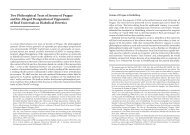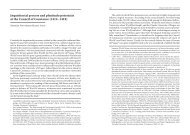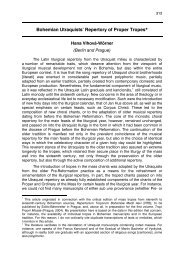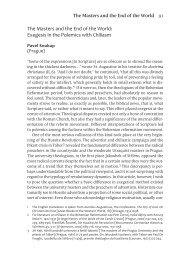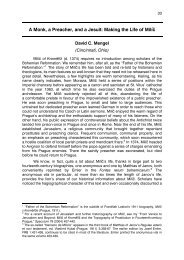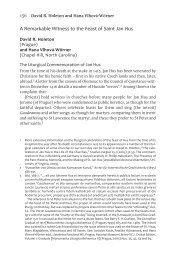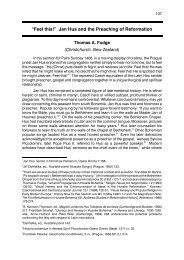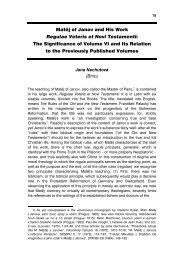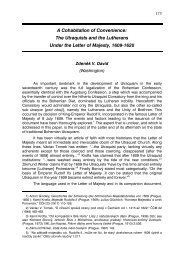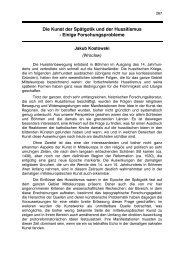The Allegory of Salvation and Sin - Bohemian Reformation and ...
The Allegory of Salvation and Sin - Bohemian Reformation and ...
The Allegory of Salvation and Sin - Bohemian Reformation and ...
Create successful ePaper yourself
Turn your PDF publications into a flip-book with our unique Google optimized e-Paper software.
<strong>The</strong> <strong>Allegory</strong> <strong>of</strong> <strong>Salvation</strong> <strong>and</strong> <strong>Sin</strong><br />
Jan Royt<br />
(Prague)<br />
247<br />
Roughly ten years ago I published, jointly with Docent Vladimír Hrubý, an<br />
article about the Lutheran <strong>Allegory</strong> <strong>of</strong> <strong>Salvation</strong> <strong>and</strong> <strong>Sin</strong> in the hall <strong>of</strong> the Castle <strong>of</strong><br />
Pardubice. 1 <strong>Sin</strong>ce then several more such discoveries have occurred, hence one<br />
may surmise that the theme was more widespread than hitherto has been assumed.<br />
<strong>The</strong> Lutheran <strong>Reformation</strong>’s attitude toward images <strong>of</strong> veneration was not<br />
entirely as negative as, for instance, is indicated by Luther’s reaction to the<br />
pilgrimages to “<strong>The</strong> Beautiful Virgin Mary <strong>of</strong> Regensburg.” 2 And it certainly was not<br />
as sweeping as the attitudes <strong>of</strong> the Unity <strong>of</strong> Brethren or <strong>of</strong> the Swiss <strong>and</strong> Dutch<br />
reformations against the didactic role <strong>of</strong> images in the liturgical space. Luther’s more<br />
tolerant view is attested in his prefaces to Passionsbüchlein <strong>and</strong> Bettbüchlein which<br />
even recommend images for the dissemination <strong>of</strong> the Christian message. In any<br />
case, many Lutheran churches have preserved numerous examples <strong>of</strong> medieval art,<br />
<strong>and</strong> churches newly built in the seventeenth century in Silesia (the so-called<br />
Friedenskirche) did not lack ecclesiastical art, albeit exclusively on biblical themes.<br />
<strong>The</strong> idea <strong>of</strong> a dogmatic allegory, also known as Lehrbild, Dogmenbild, or<br />
Dogmenallegorie, apparently emerged in the reformation milieu <strong>of</strong> Wittenberg. In all<br />
probability, Martin Luther was responsible for its origin, inasmuch as the theme <strong>of</strong><br />
the <strong>Allegory</strong> <strong>of</strong> <strong>Salvation</strong> <strong>and</strong> <strong>Sin</strong> has the same didactic bearing as Luther’s<br />
Katechismus (1529) that was published in the same period, when the allegory also<br />
presumably originated. <strong>The</strong>re is some evidence that the allegory was theologically<br />
formulated by Philip Melanchton, as can be deduced from his letter to the poet<br />
Johann Stiegel. 3 <strong>The</strong> <strong>Allegory</strong> <strong>of</strong> <strong>Salvation</strong> <strong>and</strong> <strong>Sin</strong> (or Law <strong>and</strong> Grace), emerging<br />
just before 1530, is also known in German literature as Verdammnis und Erlösung,<br />
Sünde und Gnade, Sündenfall und Erlösung, Gesetz und Gnade, or Die<br />
Rechtfertigung des Sünders durch Glauben. 4<br />
1 Jan Royt <strong>and</strong> Vladmír Hrubý, “Nástěnná malba s námětem Zákon a Milost na zámku<br />
v Pardubicích,” [Mural painting with the theme <strong>of</strong> law <strong>and</strong> grace in the castle <strong>of</strong> Pardubice] Umění 40<br />
(1992) 124-137.<br />
2 C. Altgraf zu Salm, “Neue Forsuchungen zur Schönen Madona von Regensburg,” in:<br />
Münchener Jahrbuch der Bildenden Kunst 12 (1962) 49; G. Stahl, “Die Wallfahrt zur Schönen Maria in<br />
Regensburg,” in: G. Schwaiger <strong>and</strong> J. Staber, eds., Beiträge zur Geschichte des Bistums Regensburg<br />
2 (1968) 35; A. Hubel, “Die Schöne Maria von Regensburg,” in: 850 Jahre Kollegiatsstift zu den hll.<br />
Johannes Baptist und Evangelist in Regensburg, ed. P. Mai (Munich, 1977) 45.<br />
3 H. Lilienfein, Lucas Cranach und seine Zeit (Leipzig, 1942) 54.<br />
4 See, concerning this issue, K. E. Meier, “Fortleben der religiös-dogmatischen Kompositionen<br />
Cranachs in der Kunst des Protestantismus,” Repertorium für Kunstwissenschaft 32 (1909) 415-435;<br />
P. Goldberg., Die Darstellung der Erlösung durch Christus und sein Blut und der heiligen Eucharistie<br />
in der protestantischen Kunst der <strong>Reformation</strong>szeit. Diss. Phil. Marburg 1925 (unpublished); J.<br />
Bucholz, Protestantismus und Kunst (Leipzig, 1928); H. Schrade, Die Auferstehung Christi (Berlin <strong>and</strong><br />
Leipzig, 1932) 295–298; M. J. Friedländer <strong>and</strong> J. Rosenberg, DieGemälde von Lucas Cranach (Berlin,<br />
1932) 63-64, image 186; O. Thulin, Cranach, Altäre der <strong>Reformation</strong> (Berlin, 1955); M. Lurker, Der
248<br />
<strong>The</strong> theme is based on the typology <strong>of</strong> the Old <strong>and</strong> the New Testament or, as<br />
the case may be, on their antithesis. As against the High Middle Ages that<br />
understood the relationship between the two testaments as one <strong>of</strong> preparation <strong>and</strong><br />
fulfillment, now the relationship received a sharper antithetical, confrontational<br />
character. <strong>The</strong> essence <strong>of</strong> this relationship is contained in the verses <strong>of</strong> Luke (24:44):<br />
“<strong>The</strong>se are my words that I spoke to you while I was still with you—that everything<br />
written about me in the law <strong>of</strong> Moses, the prophets, <strong>and</strong> the psalms must be<br />
fulfilled,” <strong>and</strong> <strong>of</strong> John (1:17): “<strong>The</strong> law indeed was given through Moses; grace <strong>and</strong><br />
truth came through Jesus Christ.” We can here recall the words <strong>of</strong> Paul’s Epistle to<br />
the Romans (5:12-15) that are most consonant with our theme: “<strong>The</strong>refore, just as<br />
sin came into the world through one man, <strong>and</strong> death came through sin, <strong>and</strong> so<br />
death spread to all because all have sinned — sin was indeed in the world before<br />
the law, but sin is not reckoned when there is no law. Yet death exercised dominion<br />
from Adam to Moses, even over those whose sins were not like the transgression <strong>of</strong><br />
Adam, who is a type <strong>of</strong> the one who was to come. But the free gift is not like the<br />
trespass. For if the many died through the one man’s trespass, much more surely<br />
have the grace <strong>of</strong> God <strong>and</strong> the free gift in the grace <strong>of</strong> the one man, Jesus Christ,<br />
abounded for the many,” or other verses <strong>of</strong> the Epistle (Romans 1:17): “For in it the<br />
righteousness <strong>of</strong> God is revealed through faith for faith; as it is written, ‘<strong>The</strong> one who<br />
is righteous will live by faith;’” <strong>and</strong> (Romans 3:20): “For ‘no human being will be<br />
justified in his sight’ by deeds prescribed by the law, for through the law comes the<br />
knowledge <strong>of</strong> sin.”<br />
One can fathom from Luther’s thoughts that the weapon <strong>of</strong> death is sin <strong>and</strong><br />
sin has its power from the Law, from which also comes underst<strong>and</strong>ing. <strong>The</strong> Law<br />
bears with it the wrath <strong>of</strong> God <strong>and</strong> all have sinned <strong>and</strong> are far from God’s glory; it is<br />
as though the man, depicted under the tree in the <strong>Allegory</strong> <strong>of</strong> <strong>Salvation</strong> <strong>and</strong> <strong>Sin</strong>,<br />
would ask (Romans 7:24): “Wretched man that I am! Who will rescue me from this<br />
body <strong>of</strong> death?” <strong>The</strong> sin <strong>of</strong> the progenitors, however, is not an inescapable tragedy<br />
(Romans 5:18): “<strong>The</strong>refore just as one man’s trespass led to condemnation for all,<br />
so one man’s act <strong>of</strong> righteousness leads to justification <strong>and</strong> life for all,” hence,<br />
against Adam’s fall <strong>and</strong> his grave there st<strong>and</strong>s in the Allegories <strong>of</strong> <strong>Salvation</strong> <strong>and</strong> <strong>Sin</strong><br />
“the Lamb <strong>of</strong> God who takes away the sins <strong>of</strong> the world,” as it is announced by the<br />
depicted St. John the Baptist. <strong>The</strong> sacrifice <strong>of</strong> the Lamb washes away the sins, to<br />
which humankind was seduced by the fall <strong>of</strong> Adam; the sacrifice on the cross<br />
Baum in Glauben und Kunst unter besonderer Berücksichtigung der Werke des Hieronymus Bosch<br />
(Baden–Baden <strong>and</strong> Strassbourg, 1960) 33; F. A. Grossmann, “A Religious <strong>Allegory</strong> by Hans Holbein<br />
the Younger,” Burlington Magazine 103 (1961) 491-494; D. L. Ehresmann, “<strong>The</strong> Brazen Serpent, A<br />
<strong>Reformation</strong> Motif in the Works <strong>of</strong> Lucas Cranach the Elder <strong>and</strong> his Workshop,” in: Marsyas 13 (New<br />
York University, 1967) 33-47; Cranach – Colloquium (Wittenberg, 1973) 69; Dieter Koepplin <strong>and</strong><br />
Tilman Falk, Lukas Cranach: Gemälde, Zeicnhungen, Druckgraphik: Ausstellung im Kunstmuseum<br />
Basel, 15. Juni – 8. September 1974, 2 vols. (Basel: Birkhäuser, 1974-1976) 2:505-510; K. Hiob,<br />
“Gesetz und Evangelium , Südenfall und Erlösung,” in: <strong>Reformation</strong> in Nürnberg und Bewahrung<br />
(Nurenberg, 1979) 134 -135; J. Harasimowicz, “Typy i programy śląskich ołtarzy wieku Reformacji,”<br />
Roczniki Sztuki Śląskiej 12 (1979) 7-27; F. Ohly, Gesetz und Evangelium. Zur Typologie bei Luther und<br />
Lucas Cranach. Münster 1985; Ikonographie des Protestantismus , in : Beiträge des CIHA Kolloquium<br />
– Kunst und <strong>Reformation</strong> (Leipzig, 1985) 332-340; J. Harasimowicz, “Treści i funkcje ideowe sztuki<br />
śląskej reformacji 1520-1650,” Acta Universitatis Wratislawiensis, No 819, Historia sztuki 2 (1986).
249<br />
redeems all people, beginning with Adam <strong>and</strong>, at the same time, there is the<br />
beginning <strong>of</strong> a new era, which is dominated by Grace, instead <strong>of</strong> the Law. <strong>The</strong><br />
<strong>Allegory</strong> <strong>of</strong> <strong>Salvation</strong> <strong>and</strong> <strong>Sin</strong> also very graphically elucidates one <strong>of</strong> Lutheran<br />
theology’s fundamental pillars – justification by faith. 5 According to Luther, the<br />
justification <strong>of</strong> a individual depends on his/her devout faith in God’s grace, instead <strong>of</strong><br />
human works.<br />
<strong>The</strong> allegory, therefore, was to represent humanity deciding before the Lord<br />
between sin <strong>and</strong> salvation. John the Baptist occupies an important position in these<br />
depictions. While writing his Postilla in Wartburg, Luther was fascinated by the last <strong>of</strong><br />
the prophets who, for him, was a mediator between the Old <strong>and</strong> the New<br />
Testaments, between Moses <strong>and</strong> Christ, who “… preached the Law <strong>and</strong> the Gospel,<br />
death <strong>and</strong> salvation, the letter <strong>and</strong> the spirit, sin <strong>and</strong> justice…” <strong>and</strong> further: “… in the<br />
Law there is death, in Christ there is life.” Hence, Luther advanced from the Law,<br />
which summed up the words <strong>of</strong> the dem<strong>and</strong>ing <strong>and</strong> punishing God, to the Gospel –<br />
to the Word <strong>of</strong> God, the giving <strong>and</strong> sacrificing one; the new man, liberated by the<br />
message <strong>of</strong> the Gospels, lived in “… a new world, where there is no Law, no sin, no<br />
conscience, no death, but rather unmitigated joy, justice, grace, life, salvation, <strong>and</strong><br />
honor.” On the other h<strong>and</strong>, however, Luther knew that, in this world, the Law had not<br />
ceased to perform a necessary <strong>and</strong> valid service, namely, in the civil society <strong>and</strong> in<br />
politics: “… still now, the Word <strong>of</strong> God sounds in two inseparable modes, as the Law<br />
<strong>and</strong> as the Gospel; the natural man, until his death, must live under the Law, … but<br />
his faith <strong>and</strong> his conscience must be freed from the Law.” According to Calvin (<strong>The</strong><br />
Institutes, 1535), Christ fulfils the Law, but does not abolish it; the requirement <strong>of</strong> the<br />
Law does not change, but the relationship <strong>of</strong> man to the Law may change. If “…<br />
Christ solely is posited as justice,” then the conscience “is obedient to the Law, not<br />
under the pressure <strong>of</strong> necessity, but voluntarily.”<br />
<strong>The</strong> <strong>Allegory</strong> <strong>of</strong> <strong>Salvation</strong> <strong>and</strong> <strong>Sin</strong> had its precedents in art prior to the<br />
<strong>Reformation</strong>. Dieter Koepplin <strong>and</strong> Tilman Falk cite a number <strong>of</strong> examples, such as<br />
the painting <strong>of</strong> Hans Schäufelein from 1508 with the theme, “Crucifixion with St.<br />
John the Baptist <strong>and</strong> David, in the background with Moses accepting the tablets <strong>of</strong><br />
the Law.” 6 <strong>The</strong> <strong>Allegory</strong> <strong>of</strong> <strong>Salvation</strong> <strong>and</strong> <strong>Sin</strong> spread during the sixteenth century –<br />
through paintings on tablets, frescoes, reliefs, <strong>and</strong> particularly the new graphic<br />
media – in those parts <strong>of</strong> Europe that had adopted the <strong>Reformation</strong>. In the German<br />
l<strong>and</strong>s, it was primarily Saxony; in the <strong>Bohemian</strong> Kingdom, it was Silesia, the<br />
German-inhabited towns <strong>of</strong> northwest Bohemia, <strong>and</strong> the manors <strong>of</strong> several Non-<br />
Catholic noble families. In these territories, several basic variants <strong>of</strong> the pictorial<br />
<strong>Allegory</strong> <strong>of</strong> <strong>Salvation</strong> <strong>and</strong> <strong>Sin</strong> emerged in the first half <strong>of</strong> the sixteenth century. <strong>The</strong><br />
source <strong>of</strong> these variants may be sought in two fundamental types <strong>of</strong> the image: one<br />
in Gotha (Museen der Stadt Gotha – Schlossmuseum), the other in Prague (National<br />
Gallery in Prague). <strong>The</strong> two basic types differ from each other in substantial motifs,<br />
5 Amedeo Molnár, Pohyb teologického myšlení. Přehledné dějiny dogmatu [<strong>The</strong> evolution <strong>of</strong><br />
theological thought. A short history <strong>of</strong> dogma.] (Prague, 1982) 329-336; idem, Na rozhraní věků. Cesty<br />
reformace [On the edge <strong>of</strong> the ages. <strong>The</strong> paths <strong>of</strong> reformation.] (Prague, 1985) 143-243; Bernhard<br />
Lohse, Epochy dějin dogmatu [Epochs <strong>of</strong> the history <strong>of</strong> dogma.] (Prague, 1994) 129-157; see also<br />
Bernhard Lohse, Epochen der Dogmengeschichte, 3 rd ed. rev. (Stuttgart, 1974).<br />
6 Koepplin <strong>and</strong> Falk, Lukas Cranach: Gemälde, Zeichnungen, Druckgraphik 508.
250<br />
<strong>and</strong> the Prague variant may be considered the more recent <strong>and</strong> theologically more<br />
elaborate.<br />
<strong>The</strong> Gotha Type<br />
<strong>The</strong> earliest extant variant <strong>of</strong> the <strong>Allegory</strong> <strong>of</strong> <strong>Salvation</strong> <strong>and</strong> <strong>Sin</strong> is the image in<br />
Gotha. 7 <strong>The</strong> tablet (oil tempera on a wooden tablet, 80 x 115 cm) was painted by<br />
Lucas Cranach the Elder probably in Wittenberg in 1529 (as dated on the trunk <strong>of</strong><br />
the tree). <strong>The</strong> image field <strong>of</strong> the Gotha tablet is halved by a tree, the crown <strong>of</strong> which<br />
is withered on the left side, <strong>and</strong> green on the right side. On the left half, that is, on<br />
the side <strong>of</strong> the Law, we see, under the withered branches <strong>of</strong> the tree, Moses with the<br />
tablets <strong>of</strong> the Law <strong>and</strong> three Prophets <strong>and</strong>, in the first layer, a naked sinner chased<br />
into the infernal flames by the figures <strong>of</strong> death <strong>and</strong> sin (i.e., the devil). <strong>The</strong> second<br />
layer depicts the Original <strong>Sin</strong>, <strong>and</strong> the third layer portrays the Hebrew camp with a<br />
copper serpent on a pole raised by Moses. Moses is surrounded by ailing people,<br />
who are recovering from the stings <strong>of</strong> serpents (Numbers 21:9). This Old Testament<br />
event was considered an emblematic foreboding <strong>of</strong> the Crucifixion, as suggested in<br />
the Gospel <strong>of</strong> John (3:14-15): “And just as Moses lifted up the serpent in the<br />
wilderness, so must the Son <strong>of</strong> Man be lifted up, that whoever believes in him may<br />
have eternal life.” An apocalyptic God, with a sword <strong>and</strong> with a lily in his mouth,<br />
floats in the sky, <strong>and</strong> is adored by two hosts <strong>of</strong> saints.<br />
On the contrasting right half <strong>of</strong> the tablet, the side <strong>of</strong> Grace, we see, under the<br />
green tree branches, a naked man, to whom the greatest <strong>of</strong> the prophets, John the<br />
Baptist, is showing the crucified Christ. <strong>The</strong> “naked man” is not depicted merely as<br />
“the old Adam” <strong>of</strong> the Middle Ages in contrast to Christ, but as a man <strong>of</strong> the present<br />
<strong>and</strong> <strong>of</strong> the past, for whom <strong>and</strong> for whose sins God had posited the Law, but for<br />
whom he had also rendered the sacrifice <strong>of</strong> his only Son. <strong>The</strong> naked man figures<br />
here as one between sin <strong>and</strong> grace – between the two poles <strong>of</strong> the divine order <strong>of</strong><br />
salvation. It is as if we heard Martin Luther’s words: “Gott der hat ywey Wort, eins ist<br />
das Gesetz,…das <strong>and</strong>er ist das Evangelion,” <strong>and</strong> his assurance that the life <strong>of</strong> man<br />
is: “…transitus de lege ad gratiam, de peccato ad justitiam, de Mose ad Christu.” At<br />
the foot <strong>of</strong> the cross, the victorious Lamb is treading on death <strong>and</strong> sin. In the second<br />
layer <strong>of</strong> the right half <strong>of</strong> the tablet, the resurrected Christ is floating over the cave with<br />
an empty tomb; <strong>and</strong> in the third layer, we see the image <strong>of</strong> the annunciation to the<br />
shepherds. <strong>The</strong> bottom part <strong>of</strong> the image contains scriptural quotations that are<br />
relevant to the various motifs, <strong>and</strong> largely drawn from Romans.<br />
A later variant <strong>of</strong> the image from Gotha is an image from Weimar (Gallerie im<br />
Schloss, c. 1530), a town that also was one <strong>of</strong> the important centres <strong>of</strong> the<br />
<strong>Reformation</strong>. 8 In distinction from the Gotha prototype, the theme <strong>of</strong> the allegory in<br />
Weimar is exp<strong>and</strong>ed to include a Marian component. On the right side, we see, on a<br />
rock, the Virgin Mary in an expectant state, <strong>and</strong> Christ Emmanuel with a small cross<br />
being sent to her. This may be interpreted as a reference to the Saviour’s<br />
7<br />
Kunst der <strong>Reformation</strong>szeit, ed. E. Badstübner (Berlin 1983) 358-360, image on 328.<br />
8<br />
Ibid. 357-360.
251<br />
incarnation. It would be, however, difficult to see here Mary as a sharer in Christ’s<br />
passion, or even as a co-redemptrix. Such roles would not be consonant with<br />
Lutheran theology. <strong>The</strong> latter, it is true, did not entirely rule out respect for Mary, yet<br />
saw her proper role in a strict subordination to Christ. Another fine distinction is that,<br />
on the right side, the resurrected Christ is overwhelming death <strong>and</strong> sin. Likewise, the<br />
scene <strong>of</strong> the Jewish camp with the serpent has been transferred from the left side to<br />
the right side, into the place <strong>of</strong> the annunciation to the shepherds that has entirely<br />
disappeared.<br />
As for other depictions in the style <strong>of</strong> the Weimar variant, there is a drawing in<br />
Frankfurt am Main (in Städelsches Kunstinstitut) that may be a preparatory sketch<br />
for the Weimar variant, to which it corresponds in every detail, except for the<br />
expulsion <strong>of</strong> Adam <strong>and</strong> Eve from Paradise, <strong>and</strong> the pursuit <strong>of</strong> the sinner by death. 9 It<br />
may be by Lucas Cranach the Elder himself from around the year 1530. Another<br />
specimen is the tablet from the Cranach workshop, deposited in the Germanisches<br />
Nationalmuseum in Nurenberg, <strong>and</strong> dating to the late 1529. 10 Its distinctive features<br />
are the feet <strong>of</strong> the Ascending Christ in the upper right corner, <strong>and</strong> the blood from<br />
Christ’s side shed on a human figure. An etching by Lucas Cranach from around the<br />
year 1530 is also very close to the Weimar prototype. It is among the holdings <strong>of</strong> the<br />
Department <strong>of</strong> Prints <strong>and</strong> Drawings <strong>of</strong> the British Museum in London. 11<br />
<strong>The</strong> Prague Type<br />
<strong>The</strong> other prototype is the so-called Prague image, the origin <strong>of</strong> which<br />
remains unknown. <strong>The</strong> back side <strong>of</strong> the tablet bears a small seal <strong>of</strong> the Bruntálskýs<br />
<strong>of</strong> Vrbno from the eighteenth century. Considering, however, that a number <strong>of</strong> other<br />
specimens in Bohemia repeat its characteristics, it may be assumed that it was<br />
destined for one <strong>of</strong> the Lutheran churches in northwest Bohemia. <strong>The</strong> image is<br />
included in the collections <strong>of</strong> the National Gallery in Prague under the title “<strong>The</strong><br />
Original <strong>Sin</strong> <strong>and</strong> the Redemption <strong>of</strong> Mankind.” 12 It is signed <strong>and</strong> dated 1529 <strong>and</strong>, as<br />
confirmed by Mojmír Hamzík, the signature <strong>and</strong> the date are authentic. <strong>The</strong> Prague<br />
image is iconographically <strong>and</strong> intellectually the most sophisticated specimen among<br />
the hitherto mentioned variants. It is characterized by a symmetrical arrangement <strong>of</strong><br />
the motifs.<br />
Under the tree, we see a man, who sits on a stump, with an inscription<br />
“Mensch an Gnad” underneath him. This man is deciding between, on the one<br />
h<strong>and</strong>, a prophet (with an inscription “Propheten”), that is, the Law, behind whom<br />
there is depicted a cadaver in the grave (with the inscription “Todt”), <strong>and</strong>, on the<br />
9<br />
Werner Schade, Die Malerfamilie Cranach (Dresden, 1974) image 185. See also Werner<br />
Schade, Cranach, a Family <strong>of</strong> Master Painters, trans. by Helen Sebba (New York, 1980).<br />
10<br />
Gertrud Schiller, Iconography <strong>of</strong> Christian Art, 2 vv. (London, 1971-1972) 2:259, images 533-<br />
534.<br />
11<br />
Koepplin <strong>and</strong> Falk, Lukas Cranach: Gemälde, Zeichnungen, Druckgraphik 505-509; Schade,<br />
Die Malerfamilie Cranach 88. Schade improperly attributes the etching to Lucas Cranach the<br />
Younger.<br />
12<br />
Inventory no. 010732, 72 x 88.5 cm.
252<br />
other h<strong>and</strong>, John the Baptist, who personifies Grace (with an inscription “Anzeiger<br />
Christi”) <strong>and</strong> points to the resurrected Christ – the victor over death <strong>and</strong> <strong>Sin</strong> (with an<br />
inscription “Unser Überwindung”). On the left side, there is a depiction <strong>of</strong> the<br />
Original <strong>Sin</strong> (marked by an inscription “Sunder”) <strong>and</strong>, above this scene, Moses, on a<br />
rock or a mountain receiving from God’s h<strong>and</strong>s the tablets <strong>of</strong> the Law. <strong>The</strong> last layer<br />
portrays the Jewish camp, marked by the inscription “Figur der Rechtfertigung.” On<br />
the right side, opposite the Original <strong>Sin</strong>, there st<strong>and</strong>s, above the cave with Christ’s<br />
empty grave, the Lamb marked by the inscription “Unser Unschuld.” On the same<br />
level, the crucified Christ bears the inscription “Rechtfertigung” <strong>and</strong>, on a rock above<br />
him, the Virgin Mary in an expectant state is receiving Christ Emmanuel with a small<br />
cross. An inscription behind her reads: “Engel erhalten dem Dient Christi.” A scene<br />
<strong>of</strong> the annunciation to the shepherds forms the counterpart to the Jewish camp that<br />
features the serpent. Texts that accompany the various motifs are located in the<br />
lower part <strong>of</strong> the image.<br />
<strong>The</strong> collections <strong>of</strong> the Prague National Gallery include another image <strong>of</strong> the<br />
Prague type that apparently originated in northwestern Bohemia. 13 Lastly, it was in<br />
the possession <strong>of</strong> Countess Thunová, née <strong>of</strong> Kolowraty. Hamsík, who restored the<br />
painting, dates it to the seventeenth century. Considering its art form <strong>and</strong> the<br />
surrounding historical circumstances, I would rather place the origin <strong>of</strong> the image<br />
into the second half the sixteenth century. A similar grouping <strong>of</strong> motifs, as in both<br />
Prague images, can be found on the title page <strong>of</strong> Luther’s translation <strong>of</strong> the New<br />
Testament (published in Lübeck), which was designed by Erhard Altdorfer in 1533. 14<br />
<strong>The</strong> images from Gotha, Weimar, <strong>and</strong> Prague (as well as other later variants <strong>and</strong><br />
copies) are furnished in their lower part by inscriptions <strong>of</strong> biblical verses in Latin or<br />
German (the latter in Luther’s translation) that related to the individual themes in the<br />
images. On the tablets from Gotha <strong>and</strong> Weimar there are six sets <strong>of</strong> such<br />
inscriptions; in the tablet from Prague, there are only five sets. <strong>The</strong> right sides feature<br />
excerpts from the Prophets, the Gospels <strong>and</strong> the Epistles that relate to Christ’s<br />
redemptive action, that is, to the era <strong>of</strong> Grace: Is. 7:14; Rom. 3:28; Jn. 1:29; 1 Pet.<br />
1:2; 1 Cor. 15:55-57; the quotations on the left sides refer to the era <strong>of</strong> the Law: Rom.<br />
1:18; Rom. 2:23; Rom. 3:20; Rom. 4:15; 1 Cor. 15:56.<br />
In the composition <strong>of</strong> its motifs, a fresco in the main hall <strong>of</strong> Pardubice Castle<br />
is also very close to the Prague type. 15 It occupies a sizable field between the<br />
southwestern corner <strong>and</strong> the portal leading to the hall <strong>of</strong> Vojtěch <strong>of</strong> Pernštejn. <strong>The</strong><br />
painting was severely damaged in the past, especially in the lower part, which is<br />
particularly regrettable because, in all probability, several inscriptions were<br />
destroyed. As in the previously discussed depictions <strong>of</strong> the <strong>Allegory</strong> <strong>of</strong> <strong>Salvation</strong> <strong>and</strong><br />
<strong>Sin</strong>, the rectangular field <strong>of</strong> the image is sharply divided by a tree with the crown <strong>of</strong><br />
leaves withered on the left side, <strong>and</strong> green on the right side. Sitting under the tree, a<br />
naked man with distinctly portrayed features is turning away from an Old Testament<br />
Prophet in the direction <strong>of</strong> the figure <strong>of</strong> John the Baptist, who – according to Luther’s<br />
sermon for the feast <strong>of</strong> the saint – “preached the Law <strong>and</strong> the Gospel, Death <strong>and</strong><br />
<strong>Salvation</strong>, because in the Law there is death, <strong>and</strong> in Christ there is life.”<br />
13<br />
Inventory no. 09619.<br />
14<br />
Royt <strong>and</strong> Hrubý, “Nástěnná malba s námětem Zákon a Milost na zámku v Pardubicích,” 133<br />
image 6.<br />
15<br />
Ibid. 124-137.
253<br />
<strong>The</strong> ensuing scenes, on both sides <strong>of</strong> the tree, are composed in strict<br />
symmetry. <strong>The</strong> first layer, on the left side, probably depicted the sarcophagus with a<br />
cadaver, as it appears from the painting’s fragments. On the corresponding right<br />
side, the resurrected Christ is exiting his stony grave, <strong>and</strong> with a long spear,<br />
furnished with a banner, pierces Satan. In the second layer, we see, on the left side,<br />
the scene <strong>of</strong> the Original <strong>Sin</strong>; on right side, the Lamb <strong>of</strong> God with the inscription<br />
NEVINOST [Innocence]. In the next layer, on the left from the tree, Moses kneeling<br />
on a high rock is receiving the tablets <strong>of</strong> the Law from God the Father. A scroll with<br />
the inscription ZÁKON [the Law] floats above Moses’s head. <strong>The</strong> opposite, right side<br />
is dominated by the figure <strong>of</strong> the Virgin Mary in an expectant state, <strong>and</strong><br />
accompanied by a scroll with the inscription MILOST [Grace]. Above the inscription,<br />
we see Christ Emmanuel with a little cross <strong>and</strong>, beneath him, angels with a book<br />
<strong>and</strong> a pointer. <strong>The</strong>re is a wide opening into the countryside behind the tree. On the<br />
left, we see the Jewish camp with a copper serpent on the pole; on the right on a<br />
hill, the crucified Christ, originally bearing a scroll with the inscription<br />
SPRAVEDLNOST NAŠE [Our justification]. <strong>The</strong> image is crowned by a ribbon with<br />
the inscription: ZÁKON SKRZE MOYZISSE DÁN GEST MILOST A PRAWDA SKRZE<br />
GEZISSE KRYSTA [<strong>The</strong> Law is given through Moses; Grace <strong>and</strong> Truth through<br />
Jesus Christ], which is a quotation from John (1:17). <strong>The</strong> painting in Pardubice<br />
differs from the Prague image only in minor details, such as the victory <strong>of</strong> the<br />
resurrected Christ over the monster. It is a motif that also appears in the Weimar<br />
variant, as well as in Erhart Altdorfer’s earlier-mentioned etching on the title page <strong>of</strong><br />
Luther’s New Testament edition.<br />
<strong>The</strong> reason for the occurrence <strong>of</strong> a painting with a blatantly <strong>Reformation</strong>al<br />
tendency must be sought in the religious convictions <strong>of</strong> the Pernštejns, the feudal<br />
rulers <strong>of</strong> Pardubice. <strong>The</strong> noble brothers, Vojtěch <strong>and</strong> Jan, adopted the Utraquist faith<br />
in the 1520s. <strong>The</strong>ir father, Vilém <strong>of</strong> Pernštejn, was a man <strong>of</strong> remarkable religious<br />
tolerance. In 1510, he established the church <strong>of</strong> St. John the Baptist for the<br />
Utraquists in Pardubice. Above all, he entrusted the education <strong>of</strong> his two sons to the<br />
Utraquist priest <strong>and</strong> Humanist, Jan Čejka. His son, Vojtěch, who ruled in Pardubice<br />
from 1521 to 1534, also wrote a history <strong>of</strong> the <strong>Bohemian</strong> religious wars which,<br />
however, has not survived. Even more active, Jan, who ruled from 1534 to 1538, was<br />
one <strong>of</strong> the postulators <strong>of</strong> <strong>Reformation</strong> teaching, as well as one <strong>of</strong> the “defensores” <strong>of</strong><br />
the Consistory sub utraque. In the 1530s, he sought a reorganization <strong>of</strong> Utraquism<br />
<strong>and</strong>, in 1540-1542, together with Krajíř <strong>of</strong> Krajek, a <strong>Bohemian</strong> brother, he advocated<br />
a unification <strong>of</strong> Utraquism with the Unity <strong>of</strong> Brethren. His strong religious convictions<br />
<strong>and</strong> his courage in defence <strong>of</strong> “God’s Truth” are attested by a letter <strong>of</strong> 1539, in which<br />
he refers to the doctrine <strong>of</strong> justification by faith, <strong>and</strong> reproaches Emperor Ferdin<strong>and</strong> I<br />
for his religious intolerance.<br />
<strong>The</strong> origin <strong>of</strong> the Prague tablet in 1529-1530 establishes the earliest time<br />
period for the creation <strong>of</strong> the Pardubice fresco with the theme <strong>of</strong> the <strong>Allegory</strong> <strong>of</strong><br />
<strong>Salvation</strong> <strong>and</strong> <strong>Sin</strong>. <strong>The</strong> date <strong>of</strong> the fresco can be further narrowed down because –<br />
according to expert opinion – it was contemporaneous with the creation <strong>of</strong> the<br />
surrounding décor <strong>of</strong> the hall. We can, therefore, reasonably assume that the<br />
painting was created in the first half <strong>of</strong> the 1530s (c. 1532) during the rule <strong>of</strong> Vilém <strong>of</strong><br />
Pernštejn. Thus, it is a very early example <strong>of</strong> this <strong>Allegory</strong> in central Europe. Under<br />
the existing historical circumstances, the placing <strong>of</strong> a fresco, that bore a<br />
conspicuously <strong>Reformation</strong> message into the main hall <strong>of</strong> the Pardubice Castle,<br />
must be seen as an important religious <strong>and</strong> political manifesto. It publicly signalled<br />
an adherence <strong>of</strong> the Pernštejns to the Protestant confession.
254<br />
Other Types<br />
In 1545, the <strong>Allegory</strong> <strong>of</strong> <strong>Salvation</strong> <strong>and</strong> <strong>Sin</strong> from the workshop <strong>of</strong> Lucas<br />
Cranach the Younger appeared also on the altar <strong>of</strong> St. Joachim in Jáchymov. 16 <strong>The</strong><br />
Counts Jeroným <strong>and</strong> Vavřinec Šliks ordered the erection <strong>of</strong> the altar during the last<br />
year <strong>of</strong> their joint rule in the town. It was to honour the city’s founder, Štěpán Šlik,<br />
<strong>and</strong> evidently also to perpetuate the eternal glory <strong>of</strong> their family. Unfortunately, this<br />
piece <strong>of</strong> art, undoubtedly notable both artistically <strong>and</strong> iconographically, is known<br />
only from descriptions, because it perished during a major conflagration in the town<br />
in 1873. 17 I have discussed the description <strong>of</strong> this lost specimen in a previous article<br />
in this series. 18<br />
Three other frescos with the theme <strong>of</strong> the <strong>Allegory</strong> <strong>of</strong> <strong>Salvation</strong> <strong>and</strong> <strong>Sin</strong> are <strong>of</strong><br />
more recent origin: the first one, on the external wall <strong>of</strong> the presbytery <strong>of</strong> the former<br />
monastery church in Horažďovice (not yet described in print); the second one, on<br />
the north wall <strong>of</strong> the chapel in Horšovský Týn; <strong>and</strong> the third, in the arcade <strong>of</strong> the<br />
Dominican monastery in České Budějovice. Created apparently in the years 1550-<br />
1560, the painting in Horažďovice is undoubtedly connected with the adherence <strong>of</strong><br />
Václav Švihovský to the Protestant <strong>Reformation</strong>. He had previously “purged” the<br />
monastery church <strong>of</strong> the Observants (which his ancestor, Půta Švihovský had<br />
established) <strong>of</strong> idolatrous images <strong>and</strong> statues. We know that he likewise had<br />
removed from the choir the grave <strong>of</strong> Půta Švihovský, <strong>and</strong> had the gravestone set into<br />
the wall <strong>of</strong> the church nave. In addition, Václav appointed a Protestant clergyman to<br />
preach in the church. Despite being considerably damaged, it is evident that the<br />
painting <strong>of</strong> Horažďovice st<strong>and</strong>s close to the image <strong>of</strong> the Prague type in the<br />
selection <strong>and</strong> arrangement <strong>of</strong> its motifs. On the left side, however, there is a motif <strong>of</strong><br />
the resurrected Christ that is rather untraditional.<br />
<strong>The</strong> fresco with the theme <strong>of</strong> the <strong>Allegory</strong> <strong>of</strong> <strong>Salvation</strong> <strong>and</strong> <strong>Sin</strong> has survived<br />
only in fragments on the north wall <strong>of</strong> the chapel in the castle <strong>of</strong> Horšovský Týn . It is<br />
also rooted in the Prague type but with considerable variations. Despite the<br />
conventional view in literature, the painting evidently is not connected with Jan the<br />
Younger <strong>of</strong> Lobkovice, who was a devout Roman Catholic <strong>and</strong> a defensor <strong>of</strong> the<br />
Consistory sub una. It is much more likely that the fresco owed its creation to Vilém<br />
the Elder Popel <strong>of</strong> Lobkovice in the 1590s. Originally sub una, Vilém converted to<br />
Lutheranism <strong>and</strong> was pressuring the burghers <strong>of</strong> Horšovský Týn to embrace the new<br />
faith. In the years from 1595 to 1604, he quarrelled with the Prague Archbishop<br />
Zbyněk Berka <strong>of</strong> Dubá over the right <strong>of</strong> appointing clergy on his estates. In 1609, he<br />
was elected one <strong>of</strong> the defensores, in consequence <strong>of</strong> Rudolf II’s Letter <strong>of</strong> Majesty.<br />
He was sentenced to death for his part in the <strong>Bohemian</strong> Uprising <strong>of</strong> 1618, but the<br />
sentence was change to lifetime imprisonment, thanks to the intervention <strong>of</strong> his<br />
influential uncle Zdeněk Vojtěch <strong>of</strong> Lobkovice. He died in Zbiroh in 1626.<br />
16 Jan Royt, “Horní město Jáchymov, reformace a umění,” [<strong>The</strong> mining town <strong>of</strong> Jachymov:<br />
reformation <strong>and</strong> art.] in: Ústecký sborník historický 2001. Gotické umění a jeho souvislosti [Gothic art<br />
<strong>and</strong> its context] (Ústí nad Labem, 2001) 351-359.<br />
17 R. Schmidt, Soupis památek historických a uměleckých v politickém okrese Jáchymovském<br />
[Catalogue <strong>of</strong> the historical <strong>and</strong> artistic monuments in the region <strong>of</strong> Jachymov] (Prague, 1913) 44 –<br />
45.<br />
18 Jan Royt, “<strong>The</strong> Mining Town <strong>of</strong> Jáchymov: <strong>Reformation</strong> <strong>and</strong> Art,” BRRP 5/2 (2005) 309-310.
255<br />
In České Budějovice, the theme <strong>of</strong> the <strong>Allegory</strong> <strong>of</strong> <strong>Salvation</strong> <strong>and</strong> <strong>Sin</strong> makes its<br />
appearance in a milieu sub una in the fresco in the arcade <strong>of</strong> the Dominican<br />
monastery. 19 It is not out <strong>of</strong> question that the painter was Bartoloměj Beránek-<br />
Jelínek who temporarily worked in the city <strong>and</strong> later commuted there from Český<br />
Krumlov. <strong>The</strong> severely damaged painting has the form <strong>of</strong> an epitaph. Like similar<br />
epitaphs from the milieu <strong>of</strong> Saxony, the Budějovice specimen depicts, in the lower<br />
right corner, the sizable family <strong>of</strong> the donor. Generally, it is rooted in the Prague<br />
type. Under the tree, a sitting figure <strong>of</strong> a naked man is pointing toward a prophet, but<br />
with his face turned toward John the Baptist. <strong>The</strong> left side depicts in three layers,<br />
from the bottom up: the sarcophagus with a cadaver, the scene <strong>of</strong> the Original <strong>Sin</strong>,<br />
<strong>and</strong> Moses accepting the tablets <strong>of</strong> the Law with the Jewish camp in the<br />
background. On the right, side we see the resurrected Christ destroying the Satan or<br />
the monster, <strong>and</strong> – because <strong>of</strong> the damage – can only surmise the motifs <strong>of</strong> the<br />
Virgin Mary in an expectant state, <strong>and</strong> the annunciation to the shepherds.<br />
To round out the survey, one can point to the exhibit, “Výtvarná kultura<br />
Moravy a Slezska, 1400-1550” [<strong>The</strong> Art Culture <strong>of</strong> Moravia <strong>and</strong> Silesia, 1400-1550].<br />
In the exhibit catalogue, L. Dědková published a fresco with the theme <strong>of</strong> the<br />
<strong>Allegory</strong> <strong>of</strong> Law <strong>and</strong> Grace from the church <strong>of</strong> St. Wenceslaus in Ostrava, dating to<br />
1555. 20 <strong>The</strong> image is loosely <strong>of</strong> the Prague type. <strong>The</strong> private gallery, Petr Br<strong>and</strong>l, in<br />
its exhibit “Mistři české a evropské malby” [Masters <strong>of</strong> <strong>Bohemian</strong> <strong>and</strong> European<br />
Painting] included a tablet painting <strong>of</strong> the <strong>Allegory</strong> <strong>of</strong> <strong>Salvation</strong> <strong>and</strong> <strong>Sin</strong> (57.4 x 79.5<br />
cm) from the second half <strong>of</strong> the sixteenth century, which was inappropriately<br />
connected with the name <strong>of</strong> the Netherl<strong>and</strong>s painter Joachim Patenier. Evidently, the<br />
painting was rooted in the Prague prototype but – because <strong>of</strong> its Latin inscriptions –<br />
it was reminiscent <strong>of</strong> the work with an analogous theme by Hans Holbein the<br />
Younger (c. 1535) that is held by the National Gallery in London. 21 For completeness<br />
sake, it should be added that the theme <strong>of</strong> the <strong>Allegory</strong> <strong>of</strong> <strong>Salvation</strong> <strong>and</strong> <strong>Sin</strong> also<br />
appears on the title pages or in the illustrations <strong>of</strong> <strong>Bohemian</strong> sixteenth-century<br />
imprints, for instance, in the Muzyka <strong>of</strong> Jean Josquin, or in the Bible <strong>of</strong> Bartoloměj<br />
Netolický.<br />
In conclusion, it should be emphasized that the exploration concerning the<br />
<strong>Allegory</strong> <strong>of</strong> <strong>Salvation</strong> <strong>and</strong> <strong>Sin</strong> has not yet by far been completed in the <strong>Bohemian</strong><br />
l<strong>and</strong>s. It is, therefore, to be hoped that fresh additional discoveries will be made,<br />
especially in the area <strong>of</strong> wall paintings.<br />
(Translated from the Czech by Zdeněk V. David.)<br />
19 J. Krčálová, “Symbol zákona a milosti v české renesanční malbě,” [<strong>The</strong> symbol <strong>of</strong> the law <strong>and</strong><br />
grace in Czech renaissance painting] in: Doc. Dr. Pavlu Preissovi, DrSc k 60. Narozeninám,<br />
manuscript collection, undated 104-106.<br />
20 Olomoucko, vol. 3 <strong>of</strong> Od gotiky k renesanci. Výtvarná kultura Moravy a Slezska 1400-1550.<br />
[From gothic to the renaissance: the artistic culture <strong>of</strong> Moravia <strong>and</strong> Silesia 1400-1550] (Olomouc,<br />
1999) 428-429.<br />
21 <strong>The</strong> National Galleries <strong>of</strong> Scotl<strong>and</strong> News, March-April 1981 (Edinburgh, 1981) 2.
256<br />
Fig. 1<br />
“Law <strong>and</strong> Grace” title page <strong>of</strong> Martin Luther’s Auslegung der Evangelien vom Advent<br />
bis auff Ostern…, (Wittenberg, 1528).
Fig. 2<br />
Lukas Cranach the Elder, “Law <strong>and</strong> Grace” 1528 – Gotha, Castle Museum.<br />
257
258<br />
Fig. 3<br />
Lucas Cranach the Elder. (workshop), “Law <strong>and</strong> Grace”, c. 1530 – Wiemar, Castle<br />
Art Collection.
Fig. 4<br />
Lukas Cranach the Elder, “Law <strong>and</strong> Grace” 1529 – Prague, National Gallery.<br />
259
260<br />
Fig. 5<br />
Lukas Cranach the Elder, (workshop) “Law <strong>and</strong> Grace” – Prague, National Gallery.
Fig. 6<br />
“Law <strong>and</strong> Grace” wall painting in the great hall <strong>of</strong> the castle in Pardubice, c. 1532.<br />
261
262<br />
Fig. 7<br />
“Law <strong>and</strong> Grace” wall painting in the cloister <strong>of</strong> the former Dominican convent in<br />
České Budějovice, c. 1590.
Fig. 8<br />
“Law <strong>and</strong> Grace” wall painting on the exterior <strong>of</strong> the former Franciscan Observant<br />
friary in Horažďovice, c. 1550-60.<br />
263
264<br />
Fig. 9<br />
“Law <strong>and</strong> Grace” wall painting in the Church <strong>of</strong> St. Wenceslaus in Moravaská<br />
Ostrava, 1540-55.



